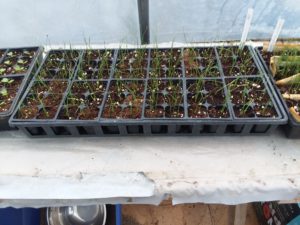Customers at the Farmers Market often ask, “How do you grow your onions so big?” While many factors go into growing big tasty onions, it’s your location in relation to the equator which matters most. In other words, what’s your latitude? Yep, that’s right, latitude.

Wagon Wheel Farm Onion seedlings started in the greenhouse in early February.
See onions form bulbs in response to day length. When the number of daylight hours reaches a certain level, onion plants start forming bulbs. Long-day onions (Northern) need about 14 to 15 hours of daylight to bulb. Short-day onions (Southern) need 10 hours of daylight. The third kind, Intermediate-day onions (Central), need about 12-14 hours.
Another important aspect to onion bulbing is temperature. Onions are photothermoperiodic; that means they are sensitive to temperature and also to daylight. Temperature and daylight hours work in tandem to slow the green top growth process and begin the bulbing process.
If you’ve selected the correct type of onion (long, short, or intermediate) for your latitude, started your onions early enough to have large green tops at precisely the time the daylight hours reach the threshold for bulbing, then you’re likely to have success growing large onions in your garden.
So what type of onion is right for me? Here at Wagon Wheel Farm in Grayson County, we grow primarily Intermediate-day onions. Typically these are onions with “candy” in their name (Red Candy, Yellow Candy, etc).
Long-day onions such as the Walla Walla, Spanish, and Copra will grow here, but will not reach the enormous size they do in the Northern States. Short-day onions such as the famous Vidalia and Texas Sweet are rarely successful unless wintered over and grown in a high tunnel. Our latitude is 36 degrees North. Too far north for short-day onions and at the very southern edge of long-day onions. Our daylight hours begin to reach 12 hours (the Intermediate-day onion thresholds) around March 15th, so we start our onions from seed in mid to late January in our greenhouse to make sure they are ready for transplanting out as close to mid-March as the weather will permit.
Planted in a bed enriched with a phosphorus-rich fertilizer and protected from frost with row cover, the focus switches to weeding, weeding, and weeding. Onions don’t like competition, so it’s very important to keep the bed weed free. We’ll discuss when to harvest and post-harvest procedures later in the year. In the meantime, purchase your seeds and get those onions started…it’s not too late.
Note: The author is not responsible for the Onion’s refusal to consider Virginia as part of the South.
Rick and Jen Cavey own and operate Wagon Wheel Farm in Independence, Virginia. They grow vegetables in a restorative manner that benefits both farm and food. To contact Rick or Jen, email: [email protected]
by Rick Cavey
